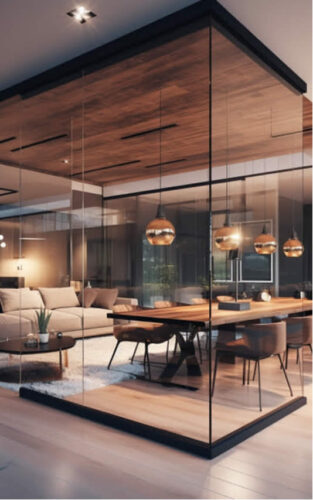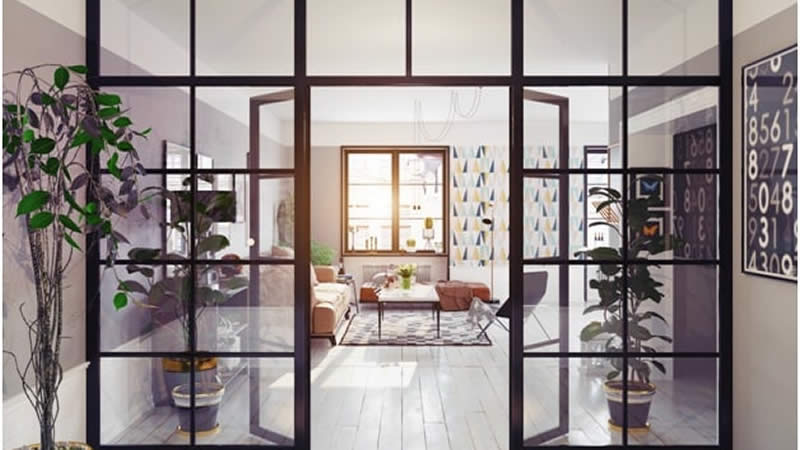Interiors in their modern design have recently moved further and further away from traditional solutions. The emphasis is more on lighting, lightness and openness of space. One of the main issues in design is the choice of material for filling internal partitions. These can be either traditional walls or glass ones, which have recently become increasingly popular. Each of these options has its advantages and disadvantages, and therefore the choice directly depends on the tasks set, the planned aesthetics and the budget that the customer has. The final choice can be made by comparing glass partitions and traditional walls – everyone decides for themselves what is better.
Reliable traditional walls
The advantages of such structures include high-quality sound insulation. Regardless of the material used to build a traditional wall – brick or plasterboard, they provide the highest level of sound insulation, which cannot be compared with glass, which is especially important for individual rooms. We are talking about offices, bedrooms or meeting rooms. In addition, with the help of a classic closed wall, you can provide complete privacy. This solution will be ideal where privacy is needed.
Walls made of traditional materials are reliable and durable. They can withstand even the heaviest loads, you can safely hang shelves, furniture and equipment on them. It is worth noting the fire resistance of such structures separately, most of the building materials used for their construction have a high fire resistance class, which is very important for safety.
However, traditional walls also have disadvantages. First of all, this is limited light. Solid structures cut off natural light, which negatively affects individual rooms. Traditional walls imply less flexibility. Changing the layout with their help is quite difficult, and it will not be cheap. Visually, such walls make the space heavier, especially in small apartments.
Light and stylish glass partitions VS traditional walls
This type of solution has recently become increasingly common not only in office spaces but also in residential premises. There are several reasons for its popularity:
- Maximum amount of light. Thanks to the transparency of such structures, natural light freely passes through the entire room, and therefore it becomes more airy and open.
- Modern design. Glass is the material that fits perfectly into a modern interior. It is actively used in co-working spaces, offices, studio apartments, etc.
- Design flexibility. Glass used to create partitions does not necessarily have to be transparent. You can choose a matte option, tinted, adorned with decorative inserts and patterns.
- The ability to visually expand the space. Thanks to the characteristics of glass partitions, they can be used for small offices and apartments, where maintaining a sense of spaciousness is especially important.
Naturally, there are certain disadvantages here too. With glass partitions, you can forget about privacy; even matte glass does not always hide everything that happens inside. In addition, sound insulation will be weak. Glass partitions require regular cleaning, and therefore it is worth initially thinking about the need for full care, otherwise it is better to opt for classic walls.

Features of installing and using glass partitions and traditional walls
Naturally, such structures are installed in different ways. Much more time is allocated for the installation of traditional walls. After their construction, there is a lot of debris left and there’s the need to carry out additional dirty work: plastering, painting, and puttying.
As for glass partitions, they are installed much faster, especially if we are talking about modular structures or sliding systems. If dismantling is required, then it can be done much easier and cleaner, thereby changing the layout if necessary.
The features of the operation of various walls also deserve special attention. If these are traditional structures, then they do not require special care, but over time they can crack and require repair or painting. Glass, as mentioned above, must be cleaned regularly, especially if the choice initially fell on a glossy and transparent option.
How universal are walls made from different materials
Stationary walls were and remain traditional. Of course, you can move them, but it is quite difficult to do this without doing major repairs. As for glass partitions, they can be easily dismantled and moved to another place. In addition, there is always the option to initially choose folding or sliding structures, which further facilitates the variability of redevelopment if necessary. Such flexibility is most often used in office spaces, co-working spaces and rental apartments, where the purpose of the rooms also changes depending on the needs of the tenants.
How expensive is it
Many people believe that glass walls are, of course, popular and attractive in appearance, but they are much more expensive than traditional ones. In fact, this is nothing more than a myth, since walls built from brick or plasterboard also require plastering and painting, which affects the final cost. It is also always worth remembering that dismantling may be required in the future, and it will also be quite expensive. Glass partitions are ready-made modules, quite competitive in price. They consists of:
- A specific type of glass and its thickness;
- The fittings used – domestic or imported;
- The presence of tinting, frosting or printing;
- The type of construction, which can be fixed or sliding.
It turns out that the choice between traditional walls and glass partitions directly depends on numerous factors. The purpose of the premises, the budget that the customer has, the style of the interior, what he wants to see in the end and even his lifestyle are important. Ideally, you can even combine both options to get the benefits of each material. Glass is used for zoning and lighting, and walls are used for insulation and privacy.

